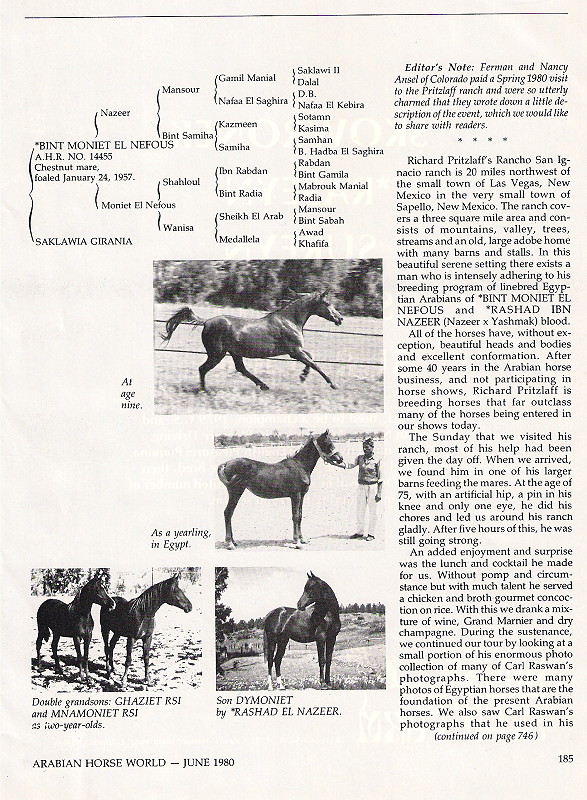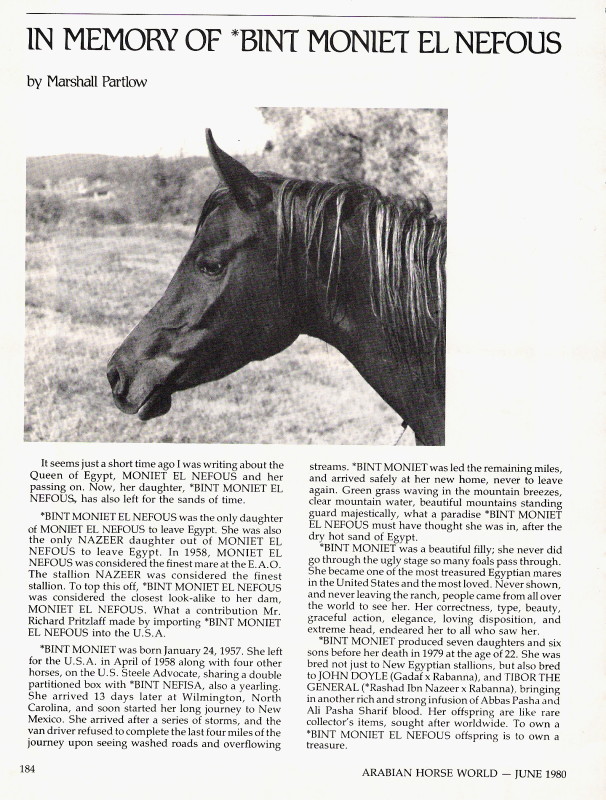We agree entirely that the Blue Catalog, Raswan followers and their satellites have done irreparable damage to certain horses and their owners without basis. Nasralla, for example, is one of those horses that came under scrutiny by Al Khamsa long ago without apparent justification and to this date, his blood is not wanted by many breeders around the world. Of course, Al Khamsa has now "approved" Nasralla for their roster, BUT the damage was done and is irreparable so far. It can be particularly difficult for newcomers to determine what is fact and what is fiction, but all a newcomer need do is consider the claims certain breeders or sellers make regarding their horses as being more rare and thus more valuable than any other horse for no other reason than a preservation label. That is a red flag that an investigation into the details of such a claim take place before accepting those statements as true. Unfortunately, Mrs. Ott seems to have suffered from a mental imbalance as she chose to shoot 10 to 21 horses (depending on who you believe) from her herd one day so they would not be used against the Blue Star Program (it was reported they were too ugly). This event is reported from two sources. The first by a man, who has declared his family was closely connected to and respected the Ott family and their Blue Star program. He stated:
"There was a difference...The Otts did not send their horses to slaughter nor were they inflicted with any discomfort. Ms Jane was very well aware of the length of time some horses took to die when injected and she watched a favourite old mare, die a painful death after the vet injected her. She stated she would NEVER again use a vet. So they were shot.
The reason a SMALL GROUP were destroyed was as follows. The mares had been sold to an individual who was going to do great things with the Blue Star mares. (This was early on) Instead he bred them to everything available. The Otts tried to purchase them back and he refused (there were rumours as to who was behind his purchase--providing the money) anyway...he ran into problems and the horses were purchased at public auction by the Otts. They knew that the resulting foals would be paraded to all, as an example of Blue Star Program breeding.
The decision was made to put down these offspring. During that time, they could have refused to register, however the anger by some, against the Blue Star program was such that the registry would have granted special consideration to register these resulting offspring WITH OR WITHOUT the permission of the Otts."
Thus the Otts destroyed otherwise healthy horses to protect the reputation of a label they created. If that isn't vanity, what is? The second by Hanna Heck-Melynk, a renowned author, researcher, breeder, international quarantine facility and owner of Serenity Arabian Farm:
"Billy Sheets Jr, (unfortunately passed away) I knew since he was 6 months old), was like a son to me and once stayed with us for almost one year. He was DEAD HONEST, very kind and intelligent, and a Wizzard of HORSES AND PEDIGREES AND A VERY HARD WORKER AND EXCELLENT RIDER. He was in tears when he told me that Ms Ott personally shot 16-18 of her horses that morning, than had to stop and called the veterinarian to do the rest, a total of 21 head. I have never seen these horses and can not judge. He was their guest various times and witnessed a alot."
The cold-blooded killing of her own horses to protect the reputation of the Blue Star program she created demonstrates Mrs. Ott lacks the very basics of compassion, is not someone who should be held in high esteem by anyone who loves horses, is not someone who should be considered an icon in the breed, is not someone to be honored and revered as a leader or role model and IS someone who put her own ego and vanity ahead of innocent living creatures. It is impossible to know beyond the pedigree the backgrounds in the ancestry of all of our horses. There is no such thing as the "purest of the pure" which is not a new revelation. The fact that we cannot go back 1,000 or even 100 years to ascertain purity in most if not all of our horses should be an easily understandable concept to grasp for anyone possessing a sound mind with critical thinking skills. Mrs. Ott mistakenly followed the writings of Carl Raswan, who was a German named Karl Schmidt, that was considered somewhat of a dreamer and a romantic story teller. According to Dr. Nagel in "Hanan: The Story of an Arabian Mare and of the Arabian Breed" on page 80, he writes "Like many foreigners, Schmidt was a frequent guest at the town house of the last powerful sheikh of the Ruala, Nouri Shalaan (which still exists today in a half-ruined state). Political intrigue, espionage and whatever else was needed for political activity and the propagation of rumours were the order of the day in those turbulent times." and on page 81, he further states "All the stud managers of El Zahraa, Dr. Zaher, Lady Wentworth and later in life Erika Schiele, regarded Raswan's idea simply as nonsense." referring to his unyielding devotion to his theory of strains, their merit, how they began and why they should be maintained. With DNA testing, we've discovered the mare families and strain names to be inaccurate for some horses, therefore, science has debunked these theories and proven the notion simple romantic fantasy. Many breeders treated the Raswan Index like a bible rather than a reference and bred according to his theories which science has disproved. As many of the preservation programs are based upon the writings of Raswan, it is only a matter of time before they take their place in history for what they have always been.
3. Another non-Egyptian preservation breeder stated *Bint Moniet El Nefous was a "poor little mare of poor structure with a pretty head that can't be bred forward with any hope of performance in mind". This man continually regurgitated this type of statement for years in an effort to promote his own bloodlines while incriminating Egyptian horses as often as possible. The fact that this mare has hundreds of performance horses with her blood coursing through their veins makes this remark, patently irresponsible and maliciously motivated.
Keep in mind *Bint Moniet El Nefous was the ONLY daughter of Moniet El Nefous to ever leave Egypt for the USA and was imported by Richard Pritzlaf, who was not the type of breeder to take direction from anyone else no matter how well politically situated those might have been. Some found him frustrating and were offended by his independent, outspoken character and were revolted by him. You can see from the articles below *Bint Moniet El Nefous was a lovely, well-built mare clearly treasured for her contribution to the breed and the herd at Rancho San Ignacio. How these self-proclaimed experts today can pick her apart today is beyond comprehension as most have never seen her or even seen these articles.
"There was a difference...The Otts did not send their horses to slaughter nor were they inflicted with any discomfort. Ms Jane was very well aware of the length of time some horses took to die when injected and she watched a favourite old mare, die a painful death after the vet injected her. She stated she would NEVER again use a vet. So they were shot.
The reason a SMALL GROUP were destroyed was as follows. The mares had been sold to an individual who was going to do great things with the Blue Star mares. (This was early on) Instead he bred them to everything available. The Otts tried to purchase them back and he refused (there were rumours as to who was behind his purchase--providing the money) anyway...he ran into problems and the horses were purchased at public auction by the Otts. They knew that the resulting foals would be paraded to all, as an example of Blue Star Program breeding.
The decision was made to put down these offspring. During that time, they could have refused to register, however the anger by some, against the Blue Star program was such that the registry would have granted special consideration to register these resulting offspring WITH OR WITHOUT the permission of the Otts."
Thus the Otts destroyed otherwise healthy horses to protect the reputation of a label they created. If that isn't vanity, what is? The second by Hanna Heck-Melynk, a renowned author, researcher, breeder, international quarantine facility and owner of Serenity Arabian Farm:
"Billy Sheets Jr, (unfortunately passed away) I knew since he was 6 months old), was like a son to me and once stayed with us for almost one year. He was DEAD HONEST, very kind and intelligent, and a Wizzard of HORSES AND PEDIGREES AND A VERY HARD WORKER AND EXCELLENT RIDER. He was in tears when he told me that Ms Ott personally shot 16-18 of her horses that morning, than had to stop and called the veterinarian to do the rest, a total of 21 head. I have never seen these horses and can not judge. He was their guest various times and witnessed a alot."
The cold-blooded killing of her own horses to protect the reputation of the Blue Star program she created demonstrates Mrs. Ott lacks the very basics of compassion, is not someone who should be held in high esteem by anyone who loves horses, is not someone who should be considered an icon in the breed, is not someone to be honored and revered as a leader or role model and IS someone who put her own ego and vanity ahead of innocent living creatures. It is impossible to know beyond the pedigree the backgrounds in the ancestry of all of our horses. There is no such thing as the "purest of the pure" which is not a new revelation. The fact that we cannot go back 1,000 or even 100 years to ascertain purity in most if not all of our horses should be an easily understandable concept to grasp for anyone possessing a sound mind with critical thinking skills. Mrs. Ott mistakenly followed the writings of Carl Raswan, who was a German named Karl Schmidt, that was considered somewhat of a dreamer and a romantic story teller. According to Dr. Nagel in "Hanan: The Story of an Arabian Mare and of the Arabian Breed" on page 80, he writes "Like many foreigners, Schmidt was a frequent guest at the town house of the last powerful sheikh of the Ruala, Nouri Shalaan (which still exists today in a half-ruined state). Political intrigue, espionage and whatever else was needed for political activity and the propagation of rumours were the order of the day in those turbulent times." and on page 81, he further states "All the stud managers of El Zahraa, Dr. Zaher, Lady Wentworth and later in life Erika Schiele, regarded Raswan's idea simply as nonsense." referring to his unyielding devotion to his theory of strains, their merit, how they began and why they should be maintained. With DNA testing, we've discovered the mare families and strain names to be inaccurate for some horses, therefore, science has debunked these theories and proven the notion simple romantic fantasy. Many breeders treated the Raswan Index like a bible rather than a reference and bred according to his theories which science has disproved. As many of the preservation programs are based upon the writings of Raswan, it is only a matter of time before they take their place in history for what they have always been.
3. Another non-Egyptian preservation breeder stated *Bint Moniet El Nefous was a "poor little mare of poor structure with a pretty head that can't be bred forward with any hope of performance in mind". This man continually regurgitated this type of statement for years in an effort to promote his own bloodlines while incriminating Egyptian horses as often as possible. The fact that this mare has hundreds of performance horses with her blood coursing through their veins makes this remark, patently irresponsible and maliciously motivated.
Keep in mind *Bint Moniet El Nefous was the ONLY daughter of Moniet El Nefous to ever leave Egypt for the USA and was imported by Richard Pritzlaf, who was not the type of breeder to take direction from anyone else no matter how well politically situated those might have been. Some found him frustrating and were offended by his independent, outspoken character and were revolted by him. You can see from the articles below *Bint Moniet El Nefous was a lovely, well-built mare clearly treasured for her contribution to the breed and the herd at Rancho San Ignacio. How these self-proclaimed experts today can pick her apart today is beyond comprehension as most have never seen her or even seen these articles.
Preservation Breeding
SC Desert Star Arabians
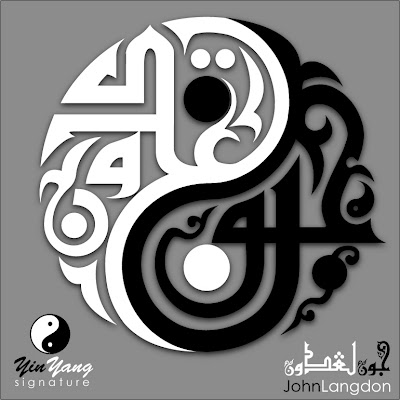
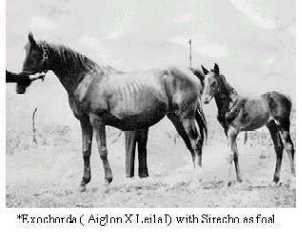
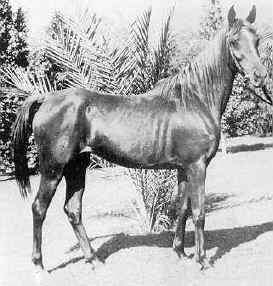
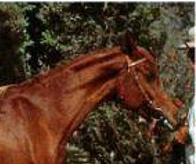
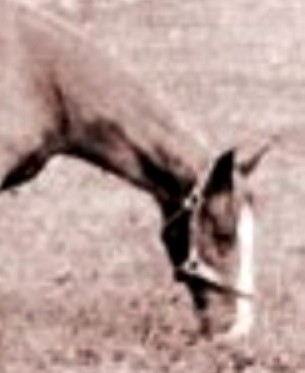
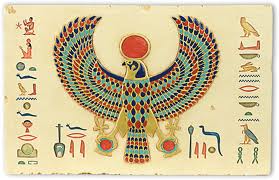


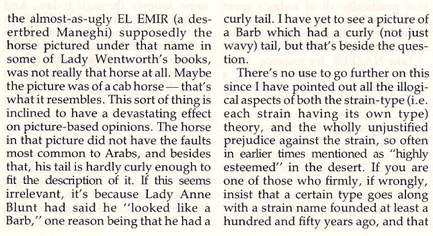
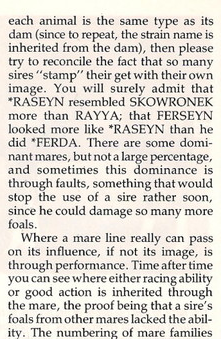
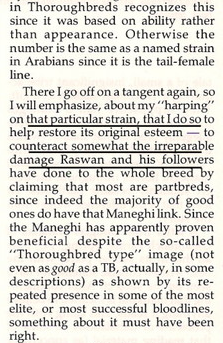
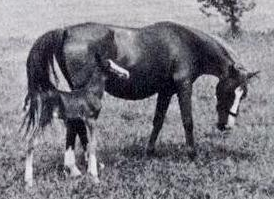
Perhaps the most important statements we can make about "Preservation Breeding" is that it has absolutely NOTHING to do with breeding a good horse. To the contrary, when too much weight is given to the pedigree and the genetic pool is reduced to few ancestors, it may become even more difficult to breed a good horse forward. The very term "preservation breeder" conjures up images of a person who wishes to be or become a breeder that devotes considerable time and money towards an effort to preserve something they have determined is worthy of their time, though one has difficulty discerning any valid reason to limit an already limited genetic pool for the straight Egyptian. Certainly there is a claim that by keeping these preservation groups separate, those "preserved" horses will provide an outcross to other straight Egyptian and pure Egyptian breeders. There are many preservation type groups today such as Babson, Blue Star or Blue List, Al Khamsa, Asil, Sheikh Obeyd, Heirloom/Pritzlaf and a variety of other non-Egyptian groups that basically adhere to breeding horses from a strictly, sometimes severely, limited genetic pool. Most of these groups have written elaborate and romantic histories that are sometimes not based on fact, or history, and they might make some sort of claim that their horses are more authentic, more pure or otherwise valuable because of their preservation label.
Some preservation breeders have produced good horses, while others may have become overly preoccupied with what the pedigree looks like on paper. The latter have failed the horse entirely in being its guardian unable to admit to themselves or anyone else having created a genetic mutation of a horse that has a variety of significant disorders or faults, i.e. being born with a wry nose (may require surgery for the foal to nurse), born without internal organs (such as ovaries or kidneys), born without the ability to live without the supplementation of vitamin E or vitamin K (inability to clot), born with crippling structural defects and a variety of other maladies that should not be tolerated in any breeding program. The first and foremost concern for ALL breeders should be the welfare and good-health of the horse for its lifetime. To breed for any other reason is to put ego and vanity ahead of the horse, who isn't just an "animal" without feelings or the inability to feel discomfort. A horse knows when it hurts and though they can't complain verbally, they can experience intense pain just as humans do. A horse feels loneliness, frustration, sadness, happiness, contentment and love. If you don't know that, then you are not yet horseman enough to breed horses and are discouraged from any type of breeding or horse ownership until you get to know what a horse is on the inside.
There are preservation breeders who claim to be ever concerned about losing certain mare families or bloodlines from the "preservation pool", but upon closer inspection, you might find a few who have had these bloodlines all along and chose not to breed them creating a "rarity" factor. This rarity factor perhaps contributes to a sense of urgency should one be inclined to want to "help" preserve these rare steeds. It is particularly important for the newcomer to do their homework thoroughly before parting with hard earned thousands so as not to be defrauded of their hard earned thousands (which is true when buying any horse too). For every statement made as fact, it will be incumbent upon the buyer or newcomer to prove to themselves it is indeed a FACT lest they be hoodwinked by smoke and mirrors. Questioning these individuals can be a lesson in perseverance and the ability to stay focused on getting the answer to your questions. Many have tried, but were unmercifully attacked, belittled and scorned. It seems for some preservation breeders, their own vanity will elicit an aggressive, mean spirited response to any persistent questioning geared towards discovering the facts and truth. More than one has stated "How dare you question the integrity of so and so" for attempting to clarify any statement they've made. When F. Scott Fitzgerald said in Tender is the Night and the Last Tycoon "If you spend your life sparing people’s feelings and feeding their vanity, you get so you can’t distinguish what should be respected in them" it's almost as if he was referring specifically to some of these horse people. It will be a test of your personal strengths and will to survive your search for the truth and knowledge unscathed when interacting with some of these.
With that in mind, note these instances where the preservation groups and breeders stray from reality in the face of little opposition, delving deep into fantasy, clinging to their own fanatical creations with such fervor they've killed their own horses, and publicly defamed good people and good breeders who have disagreed with them, asked clarifying questions publicly or proven them wrong.
1. There was a beautifully romantic story written in 2001 about an imported mare named *Exochorda entitled "The Little Bride - The Story of *Exochorda". This was an article of historical importance and remained a current piece to Sheykh Obeyd Foundation International until 19 Feb 2009 when the article was removed (not corrected). The author of the article infers the mare was a gift from a King to an American that was the president of a steamship company and that she was imported on the ship named the Exochorda. A renowned researcher from Cornell by the name of Melissa Paul proved both of these statements to be false. First, Ms Paul found an article in the New York Times and goes on to say "Maybe people are making a big assumption from the headline, but nowhere in the article does it say the King gave the horses. It explicity does say who did. "The animals were the gift of Mohamed Pasha Famy". Second, Ms. Paul stated "Carol W. Mulder and I have been doing a little research. I'm now willing to come out and say that neither Leila II nor Ibn Nafa were imported in 1931. Neither horse came to the US on the Exochorda. Both of them arrived on August 20, 1930 on board the Exanthia of the American Export Line". Ms. Paul was entirely correct in saying people are making a big assumption and it would appear that this has been done throughtout the history of many preservation groups.
The author of this article goes on to "evaluate" the quality of this mare and rates her as "quite superior" to the Queen of the Nile, Moniet El Nefous, a mare that created a dynasty of her own and who is respected by serious breeders the world over:
"Leila II (who we have come to know as *Exochorda), was a Saqlawi mare born in Egypt in the early part of the 1920s. A demure mare, Leila II stood only 14.2 hands high and weighed about 825 pounds. From old, unopposed photos she appears to have been very refined and balanced with an excellent length and slope of shoulder. Her neck was elegant and feminine, set high and rising smoothly from moderately high, well defined withers. Her fine, clean throatlatch and teacup muzzle reminds us of Moniet El Nefous, and while also chestnut in color, her conformation appears quite superior to Moniet's. Her hind quarter was strong and her hip deep, her croup remarkably level and her tailset very high. Her legs appear dry and refined, her pasterns sloped at a very good angle. Though the details of her face are not clearly seen from the photos -- it has been described as “deserty” and pretty, especially when compared to her contemporaries."
Comparing the photos below where *Exochorda, left and middle (in middle photo age 15 according to AHA records or age 17 according to the author) and Moniet El Nefous, right, at age 20, it suggests the author's judgment relative to the quality of the structure of these mares is skewed:
Some preservation breeders have produced good horses, while others may have become overly preoccupied with what the pedigree looks like on paper. The latter have failed the horse entirely in being its guardian unable to admit to themselves or anyone else having created a genetic mutation of a horse that has a variety of significant disorders or faults, i.e. being born with a wry nose (may require surgery for the foal to nurse), born without internal organs (such as ovaries or kidneys), born without the ability to live without the supplementation of vitamin E or vitamin K (inability to clot), born with crippling structural defects and a variety of other maladies that should not be tolerated in any breeding program. The first and foremost concern for ALL breeders should be the welfare and good-health of the horse for its lifetime. To breed for any other reason is to put ego and vanity ahead of the horse, who isn't just an "animal" without feelings or the inability to feel discomfort. A horse knows when it hurts and though they can't complain verbally, they can experience intense pain just as humans do. A horse feels loneliness, frustration, sadness, happiness, contentment and love. If you don't know that, then you are not yet horseman enough to breed horses and are discouraged from any type of breeding or horse ownership until you get to know what a horse is on the inside.
There are preservation breeders who claim to be ever concerned about losing certain mare families or bloodlines from the "preservation pool", but upon closer inspection, you might find a few who have had these bloodlines all along and chose not to breed them creating a "rarity" factor. This rarity factor perhaps contributes to a sense of urgency should one be inclined to want to "help" preserve these rare steeds. It is particularly important for the newcomer to do their homework thoroughly before parting with hard earned thousands so as not to be defrauded of their hard earned thousands (which is true when buying any horse too). For every statement made as fact, it will be incumbent upon the buyer or newcomer to prove to themselves it is indeed a FACT lest they be hoodwinked by smoke and mirrors. Questioning these individuals can be a lesson in perseverance and the ability to stay focused on getting the answer to your questions. Many have tried, but were unmercifully attacked, belittled and scorned. It seems for some preservation breeders, their own vanity will elicit an aggressive, mean spirited response to any persistent questioning geared towards discovering the facts and truth. More than one has stated "How dare you question the integrity of so and so" for attempting to clarify any statement they've made. When F. Scott Fitzgerald said in Tender is the Night and the Last Tycoon "If you spend your life sparing people’s feelings and feeding their vanity, you get so you can’t distinguish what should be respected in them" it's almost as if he was referring specifically to some of these horse people. It will be a test of your personal strengths and will to survive your search for the truth and knowledge unscathed when interacting with some of these.
With that in mind, note these instances where the preservation groups and breeders stray from reality in the face of little opposition, delving deep into fantasy, clinging to their own fanatical creations with such fervor they've killed their own horses, and publicly defamed good people and good breeders who have disagreed with them, asked clarifying questions publicly or proven them wrong.
1. There was a beautifully romantic story written in 2001 about an imported mare named *Exochorda entitled "The Little Bride - The Story of *Exochorda". This was an article of historical importance and remained a current piece to Sheykh Obeyd Foundation International until 19 Feb 2009 when the article was removed (not corrected). The author of the article infers the mare was a gift from a King to an American that was the president of a steamship company and that she was imported on the ship named the Exochorda. A renowned researcher from Cornell by the name of Melissa Paul proved both of these statements to be false. First, Ms Paul found an article in the New York Times and goes on to say "Maybe people are making a big assumption from the headline, but nowhere in the article does it say the King gave the horses. It explicity does say who did. "The animals were the gift of Mohamed Pasha Famy". Second, Ms. Paul stated "Carol W. Mulder and I have been doing a little research. I'm now willing to come out and say that neither Leila II nor Ibn Nafa were imported in 1931. Neither horse came to the US on the Exochorda. Both of them arrived on August 20, 1930 on board the Exanthia of the American Export Line". Ms. Paul was entirely correct in saying people are making a big assumption and it would appear that this has been done throughtout the history of many preservation groups.
The author of this article goes on to "evaluate" the quality of this mare and rates her as "quite superior" to the Queen of the Nile, Moniet El Nefous, a mare that created a dynasty of her own and who is respected by serious breeders the world over:
"Leila II (who we have come to know as *Exochorda), was a Saqlawi mare born in Egypt in the early part of the 1920s. A demure mare, Leila II stood only 14.2 hands high and weighed about 825 pounds. From old, unopposed photos she appears to have been very refined and balanced with an excellent length and slope of shoulder. Her neck was elegant and feminine, set high and rising smoothly from moderately high, well defined withers. Her fine, clean throatlatch and teacup muzzle reminds us of Moniet El Nefous, and while also chestnut in color, her conformation appears quite superior to Moniet's. Her hind quarter was strong and her hip deep, her croup remarkably level and her tailset very high. Her legs appear dry and refined, her pasterns sloped at a very good angle. Though the details of her face are not clearly seen from the photos -- it has been described as “deserty” and pretty, especially when compared to her contemporaries."
Comparing the photos below where *Exochorda, left and middle (in middle photo age 15 according to AHA records or age 17 according to the author) and Moniet El Nefous, right, at age 20, it suggests the author's judgment relative to the quality of the structure of these mares is skewed:
The mare *Exochorda appears to be over at the knee (possibly tied in at the knee as well), is out of balance in overall body structure with a shorter neck, and is straighter in the shoulder, with mutton withers (you'd miss those "well defined withers" while riding down a steep hill). She had just 6 foals in her lifetime and the foal in the photo above was her last named Sirecho. (Why only 6 foals if she was "quite superior" to Moniet El Nefous?) While Moniet El Nefous, having had 11 foals by the age of 20 (she's 20 in the photo) out of a lifetime of 13 foals -with her last at age 24, is the epitome of an ideal arabian mare. To further demonstrate the author's liberally embellished, and romantic portrayal of this mare, a founding mare of this preservation group, one need only look at the head study photos below with *Exochorda on the left and Moniet El Nefous in the two photos on the right keeping in mind the author's flowery description of *Exochorda as pretty with a teacup muzzle:
The description of *Exhochorda's head on the left as deserty and pretty and as having a teacup muzzle are gross exaggerations. William R. Brown, President of AHA at the time, when deciding whether or not to register her with AHA wrote "Her pedigree seems weak to me and looks like one of the racers off the Cairo track. That the position of refusing Egyptian Agricultural Soc. OK is rather embarrassing and asking what they think and would do". The President of AHA noted the mare was COMMON - like a racer off the track. Surely he would know the truth, would have stated so if the mare was "special" in any way, but he did not. He was not romantically inspired to embellish the truth and wasn't politically motivated in his evaluation of her as he saw her and hundreds of others in the flesh as part of his job. The RAS/EAO did not breed her, she was bred by a private breeder and it took a year for President Brown to get her registration in order. In a note from EAO El Zahraa written to Liz Dieter of March 2, 2012 "Exochorda is not and never was in the breeding programme of ElZahraa horses, ElZahraa breeding programme including along the history Arabians well known and well collected from the kings and sheiks, princes as you known, as for excorda it is in some private arabians, that means BELONGING TO OWNERS NOT THE E.A.O." In order to fully understand that note, one must accept that the EAO does not discriminate against bloodlines or exclude specific horses; rather, they use all bloodlines (known to be pure Egyptian only from the stables of Kinds, Princes and Sheikhs) to keep their herd as diverse as possible. The EAO did not, and has not to this date used the blood of *Exochorda. Unfortunately, when it comes to this mare, several organizational groups relied on AHA records or the Raswan Index regarding imports before including them into their foundation horses. These sources were wrong about this mare and underscores the need for each of us to make serious efforts of our own to prove certain claims as actual facts. Because of this gaffaw, some preservation groups changed their definitions of what was acceptable in their foundation stock in order to coincide with their earlier acceptance of *Exochorda as a foundation mare, while at the same time excluding other horses with similar backgrounds. Political motivations become apparent when these facts are known and their credibility is lessened. People will say "It's their rules and up to them" and that's true, but not when their own rules contradict themselves.
Another "founder" of one of the preservation programs, the Blue Catalog (Blue Star, Blue List), was Mrs. Ott who decided she alone knew what a purebred arabian was and declared those entitled to be Blue Star as the "purest of the pure" while others could be sublisted because she didn't like the way they looked, like Basilisk, or worse, referred to as mongrels because she decided they were not purebred at all. There are a few breeders today who continue to subscribe to Ott's self-defined preservation program which was also based on the writings of Carl Raswan. Gladys Brown Edwards wrote an excellent article expressing her thoughts about the Blue Catalog people and here are some excerpts which we wholeheartedly agree with:
Another "founder" of one of the preservation programs, the Blue Catalog (Blue Star, Blue List), was Mrs. Ott who decided she alone knew what a purebred arabian was and declared those entitled to be Blue Star as the "purest of the pure" while others could be sublisted because she didn't like the way they looked, like Basilisk, or worse, referred to as mongrels because she decided they were not purebred at all. There are a few breeders today who continue to subscribe to Ott's self-defined preservation program which was also based on the writings of Carl Raswan. Gladys Brown Edwards wrote an excellent article expressing her thoughts about the Blue Catalog people and here are some excerpts which we wholeheartedly agree with:
Gladys Brown Edwards was right when she said "A recent "letter to the Editor" stated that I seemed to have "some kind of warped obsession with the Munigiat (sic) strain"and that I continually "harped on it." I don't know how "warped" my "obsession" with it may be, but I can say this, it is in no way as warped or at all as "obsessed" as the "Blue Catalog" people are, or any other of Raswan's satellites." GBE goes on to say:
Website designed by Cath copyright 2012
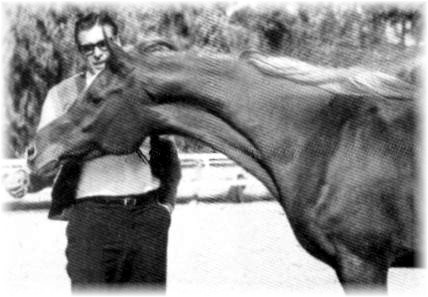
Why do these preservation breeders find fit to belittle and minimize the contributions of Moniet El Nefous and her daughter *Bint Moniet El Nefous to the breed? Why have they chosen to undermine the reputation of these mares? Could it be they are so small minded and absolutely stupid they have to incriminate them to promote their own bloodlines? Or is it because this mare has had a world-wide impact that none of their mare lines have been able to match and they are simply green with envy? Whatever the reasons, it is unacceptable to degrade this mare while making flowery exaggerations of other mares of lesser quality and repute.
Most preservation groups now deny they exist because they think or have thought their horses more pure than anyone else's (since it has become unpopular to claim "super" purity). This is in spite of the fact their websites still claim their bases (their very foundation) as one of purity. That contradiction notwithstanding, they now claim their foremost goal is one of preserving a horse no one else has to infuse the much needed "outcross" blood in the balances of the breed. Outcross blood? That might be considered logical if not for the fact that many Egyptian horses already have that blood in them! Preservationism is an effort of exclusion, not inclusion. They wrote their doctrines based upon excluding horses that were "impure" or otherwise disliked, while the rest of the world had included all the bloodlines including those being "preserved" by these groups. There simply is no rational sense to be made of this smoke screen and it might be prudent for them to acknowledge the romance and appeal of most preservation groups have become obsolete thanks to modern technology and science - both venues where establishing facts over fantasy is welcomed.
Politics played a role in the establishment of these preservation groups and still do to this day if only to maintain their position as some type of authority on pedigrees, purity, breeding authorities or leaders in the community - all utter nonsense under the guise of preservation alone. Truthfully, preservation groups or labels have absolutely NOTHING to do with breeding a good horse and can sometimes hinder that effort. Breeding pure Egyptian arabian horses is best done by following the EAO El Zahraa Stud. They are the authority on what is pure Egyptian, always have been and always will be, given they are the government stud of Egypt. Groups created by westerners are simply cliques of people advocating for their own preferences that they deem, illogically so, more valuable or somehow more rare. They have little justification in determining what is pure Egyptian or Asil over the EAO, who is the one and only true authority when it comes to breeding pure Egyptian.
What good sense is, when it comes to breeding arabian horses, above all else, is for breeders to preserve a solid, sane, classic pure Egyptian arabian horse for the future. An honest horse that can be ridden, easily managed, that will remain serviceably sound for it's lifetime of use and that will be a joy to watch because of it's natural, classic beauty and arabian animation - all of which have little or nothing to do with a label or romantic fantasy. If a breeder can stay focused on that, our future looks very bright.
Most preservation groups now deny they exist because they think or have thought their horses more pure than anyone else's (since it has become unpopular to claim "super" purity). This is in spite of the fact their websites still claim their bases (their very foundation) as one of purity. That contradiction notwithstanding, they now claim their foremost goal is one of preserving a horse no one else has to infuse the much needed "outcross" blood in the balances of the breed. Outcross blood? That might be considered logical if not for the fact that many Egyptian horses already have that blood in them! Preservationism is an effort of exclusion, not inclusion. They wrote their doctrines based upon excluding horses that were "impure" or otherwise disliked, while the rest of the world had included all the bloodlines including those being "preserved" by these groups. There simply is no rational sense to be made of this smoke screen and it might be prudent for them to acknowledge the romance and appeal of most preservation groups have become obsolete thanks to modern technology and science - both venues where establishing facts over fantasy is welcomed.
Politics played a role in the establishment of these preservation groups and still do to this day if only to maintain their position as some type of authority on pedigrees, purity, breeding authorities or leaders in the community - all utter nonsense under the guise of preservation alone. Truthfully, preservation groups or labels have absolutely NOTHING to do with breeding a good horse and can sometimes hinder that effort. Breeding pure Egyptian arabian horses is best done by following the EAO El Zahraa Stud. They are the authority on what is pure Egyptian, always have been and always will be, given they are the government stud of Egypt. Groups created by westerners are simply cliques of people advocating for their own preferences that they deem, illogically so, more valuable or somehow more rare. They have little justification in determining what is pure Egyptian or Asil over the EAO, who is the one and only true authority when it comes to breeding pure Egyptian.
What good sense is, when it comes to breeding arabian horses, above all else, is for breeders to preserve a solid, sane, classic pure Egyptian arabian horse for the future. An honest horse that can be ridden, easily managed, that will remain serviceably sound for it's lifetime of use and that will be a joy to watch because of it's natural, classic beauty and arabian animation - all of which have little or nothing to do with a label or romantic fantasy. If a breeder can stay focused on that, our future looks very bright.
